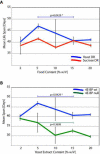Dominant-negative Dmp53 extends life span through the dTOR pathway in D. melanogaster
- PMID: 20117129
- PMCID: PMC2988653
- DOI: 10.1016/j.mad.2010.01.007
Dominant-negative Dmp53 extends life span through the dTOR pathway in D. melanogaster
Abstract
Expression of dominant-negative (DN) versions of the Drosophila ortholog of the tumor suppressor p53 extends fly life span in a Calorie Restriction (CR) dependent manner. DN-Dmp53 expression furthermore leads to reduction of Drosophila insulin-like peptide (dILP) 2 mRNA levels and a decrease in insulin/insulin-like growth factor-signaling activity (IIS) in the fly fat body. It is unclear by which mechanisms DN-Dmp53 extends longevity, and whether modulation of insulin-signaling activity plays a pivotal role in life span regulation by Dmp53. Here we show that life span extension due to DN-Dmp53 expression is likely due to reduction of Dmp53 activity and that decreased Dmp53 activity does not extend life span when dILP2 is concomitantly over expressed. Furthermore, extended longevity due to DN-Dmp53 expression does not further extend the life span of flies over expressing the IIS associated transcription factor dFoxO, indicating that DN-Dmp53-dependent life span extension may be related to IIS. However, reduction of dFoxO levels does not decrease DN-Dmp53-dependent longevity extension. Interestingly, when DN-Dmp53 is expressed in flies lacking the translation initiation controlling factor Thor/4E-BP, the downstream target of dTOR signaling, no increase in life span is observed. Taken together, these data suggest that Dmp53 may affect life span by differentially engaging the IIS and dTor pathways.
2010 Elsevier Ireland Ltd. All rights reserved.
Figures





Similar articles
-
Expression of dominant-negative Dmp53 in the adult fly brain inhibits insulin signaling.Proc Natl Acad Sci U S A. 2007 Aug 14;104(33):13355-60. doi: 10.1073/pnas.0706121104. Epub 2007 Aug 8. Proc Natl Acad Sci U S A. 2007. PMID: 17686972 Free PMC article.
-
dSir2 and Dmp53 interact to mediate aspects of CR-dependent lifespan extension in D. melanogaster.Aging (Albany NY). 2009 Jan;1(1):38-48. doi: 10.18632/aging.100001. Aging (Albany NY). 2009. PMID: 19851477 Free PMC article.
-
Neuronal expression of p53 dominant-negative proteins in adult Drosophila melanogaster extends life span.Curr Biol. 2005 Nov 22;15(22):2063-8. doi: 10.1016/j.cub.2005.10.051. Curr Biol. 2005. PMID: 16303568
-
Fat tissue and long life.Obes Facts. 2008;1(4):176-82. doi: 10.1159/000145930. Epub 2008 Aug 14. Obes Facts. 2008. PMID: 20054178 Free PMC article. Review.
-
Ketone bodies mimic the life span extending properties of caloric restriction.IUBMB Life. 2017 May;69(5):305-314. doi: 10.1002/iub.1627. Epub 2017 Apr 3. IUBMB Life. 2017. PMID: 28371201 Review.
Cited by
-
Gene expression signatures of human cell and tissue longevity.NPJ Aging Mech Dis. 2016 Jul 7;2:16014. doi: 10.1038/npjamd.2016.14. eCollection 2016. NPJ Aging Mech Dis. 2016. PMID: 28721269 Free PMC article.
-
Development of diet-induced insulin resistance in adult Drosophila melanogaster.Biochim Biophys Acta. 2012 Aug;1822(8):1230-7. doi: 10.1016/j.bbadis.2012.04.012. Epub 2012 Apr 20. Biochim Biophys Acta. 2012. PMID: 22542511 Free PMC article.
-
RPD3 histone deacetylase and nutrition have distinct but interacting effects on Drosophila longevity.Aging (Albany NY). 2015 Dec;7(12):1112-29. doi: 10.18632/aging.100856. Aging (Albany NY). 2015. PMID: 26647291 Free PMC article.
-
The function of Drosophila p53 isoforms in apoptosis.Cell Death Differ. 2015 Dec;22(12):2058-67. doi: 10.1038/cdd.2015.40. Epub 2015 Apr 17. Cell Death Differ. 2015. PMID: 25882045 Free PMC article.
-
dSir2 and longevity in Drosophila.Exp Gerontol. 2011 May;46(5):391-6. doi: 10.1016/j.exger.2010.08.007. Epub 2010 Aug 20. Exp Gerontol. 2011. PMID: 20728527 Free PMC article. Review.
References
-
- Bauer JH, Poon PC, Glatt-Deeley H, Abrams JM, Helfand SL. Neuronal expression of p53 dominant-negative proteins in adult Drosophila melanogaster extends life span. Curr Biol. 2005;15:2063–2068. - PubMed
-
- Bensaad K, Tsuruta A, Selak MA, Vidal MN, Nakano K, et al. TIGAR, a p53-inducible regulator of glycolysis and apoptosis. Cell. 2006;126:107–120. - PubMed
-
- Bernal A, Schoenfeld R, Kleinhesselink K, Kimbrell DA. Loss of Thor, the single 4E-BP gene of Drosophila, does not result in lethality. Dros. Inf. Serv. 2004;87:81–84.
Publication types
MeSH terms
Substances
Grants and funding
LinkOut - more resources
Full Text Sources
Molecular Biology Databases
Research Materials
Miscellaneous

